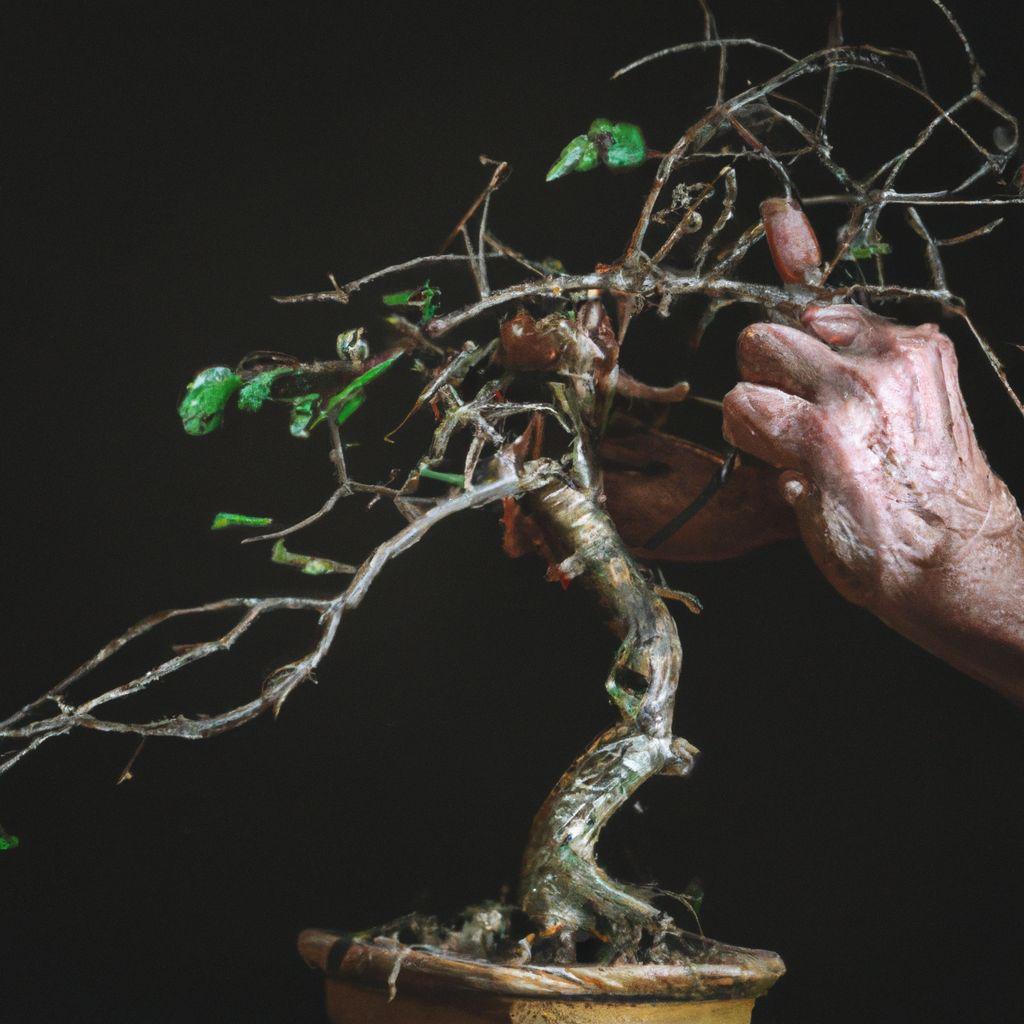Key takeaway:
- Grafting allows for the propagation of bonsai trees by joining cuttings onto rootstocks, resulting in desired characteristics.
- Techniques for bonsai grafting include scion grafting, approach grafting, and thread grafting, each offering unique benefits and considerations.
- Proper care and protection, both before and after grafting, are crucial for the success and health of the bonsai tree.
- Grafting Japanese Maple bonsai trees requires specific steps and tools, offering various benefits such as enhancing tree shape and adding branches.
- Bonsai propagation can also be achieved through methods such as seed propagation, cutting propagation, air layering propagation, and grafting propagation, each with its own pros and cons.
- Choosing suitable tree species for bonsai propagation depends on the desired propagation method, with different species suitable for seed propagation, cutting propagation, air layering propagation, and grafting propagation.
- Grafting in bonsai has various applications, including adding branches, improving tree shape, enhancing nebari by adding roots, and creating multi-trunk style bonsai.
- Familiarity with important terms and concepts in bonsai grafting is essential for successful propagation and care of bonsai trees.
Introduction
Grafting and propagation are key practices in bonsai cultivation. Plant parts are joined to create new plants with specific characteristics. Grafting results in a unique and aesthetic bonsai tree by combining different tree species or varieties. Propagation reproduces bonsai trees via cuttings, layering, and seed germination. Together, these techniques contribute to the diversity and beauty of the bonsai world.
To graft bonsai, the scion (top part) and rootstock (bottom part) must be carefully matched at the cambium layers. The scion adds leaves, aesthetics, or flower colors. The rootstock gives the bonsai tree its root system. This creates unique bonsai trees not found in nature.
Propagation methods include cuttings, layering, and seed germination. Cuttings are pieces of a mother tree which develop roots and become a new tree. Layering involves bending a branch of a tree to the ground; once rooted, the branch can be separated from the parent tree. Germination sows the seeds of a bonsai tree; the new trees have traits similar to their parent.
Grafting and propagation have centuries-old roots in ancient Chinese and Japanese cultures. Today, bonsai enthusiasts experiment and refine skills to create remarkable and unique bonsai specimens. Bonsai grafting and propagation exemplify humans’ timeless beauty and dedication to nature.
Techniques for Bonsai Grafting
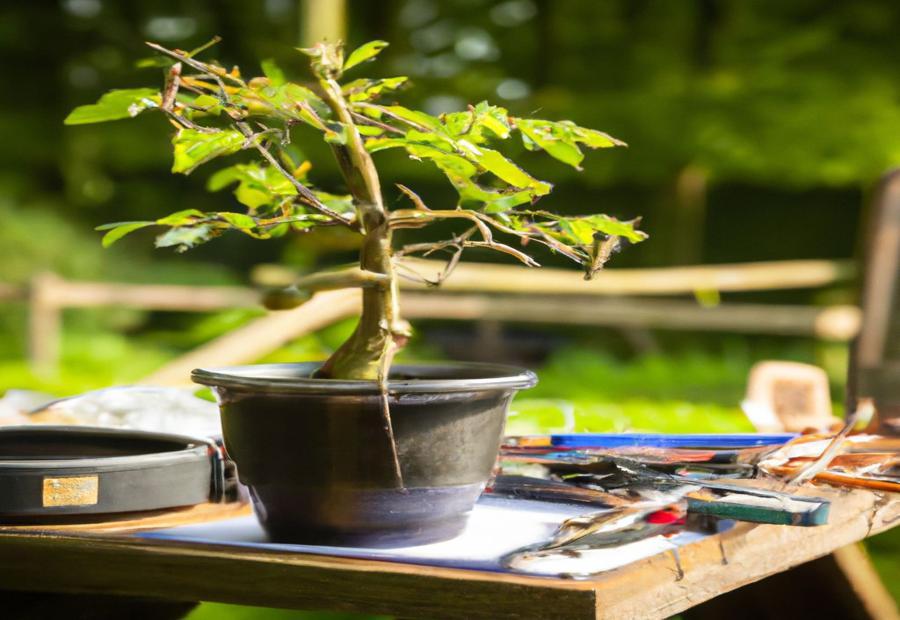
Photo Credits: Gardeninggurus.Org by Philip Hill
Bonsai enthusiasts, get ready to learn about the various techniques for bonsai grafting. In this section, we will explore scion grafting, approach grafting, and thread grafting. Each approach offers unique methods and considerations for successful bonsai grafting. Whether you’re a beginner or a seasoned bonsai gardener, these grafting techniques will broaden your understanding and improve your skills in shaping and nurturing these miniature masterpieces.
Scion Grafting
Scion Grafting is a powerful tool used by bonsai enthusiasts to customize their trees. Carefully selecting scions with desirable traits, bonsai artists can shape their trees to their vision. Additionally, this technique allows for experimentation in creating new varieties or enhancing existing ones.
Approach Grafting is also used in bonsai cultivation when trees need extra “support”. Together, these two techniques give bonsai artists various methods to enhance the growth of their trees.
With skill and attention to detail, bonsai artists can use scion grafting for precise control over the traits and features of their bonsai trees. This results in stunning and unique creations.
Approach Grafting
Approach grafting is a technique used in bonsai propagation. It joins a branch from one tree onto the trunk of another. This method helps create new branches and is great for shaping bonsai trees.
To do this, there are five steps:
- Choose the desired branch from the donor tree.
- Make a small incision on the recipient trunk.
- Cut a corresponding incision on the branch.
- Fit the cut ends together firmly.
- Secure the graft with wrap or binding material.
This technique offers several benefits. It enables precise control over branch placement and direction. This leads to improved tree shape and aesthetics. Plus, it helps create more complex branching patterns, giving a mature look.
Thread Grafting
- Select a scion: Choose a healthy branch that matches the desired size and characteristics.
- Make an incision: Cut into the tree, deep enough for the scion to fit snugly.
- Attach with thread: Wrap a piece of thread around the scion and trunk. Make it tight, but not too tight.
- Provide care: Monitor the grafted branch. Make sure it receives light, water, and nutrients. Protect it from harsh weather and pests.
Thread grafting can help create intricate designs and shapes. It repairs damaged or weakened areas by adding new growth. Though it sounds complex, these steps will help you succeed like a bonsai master.
Grafting Steps and Considerations
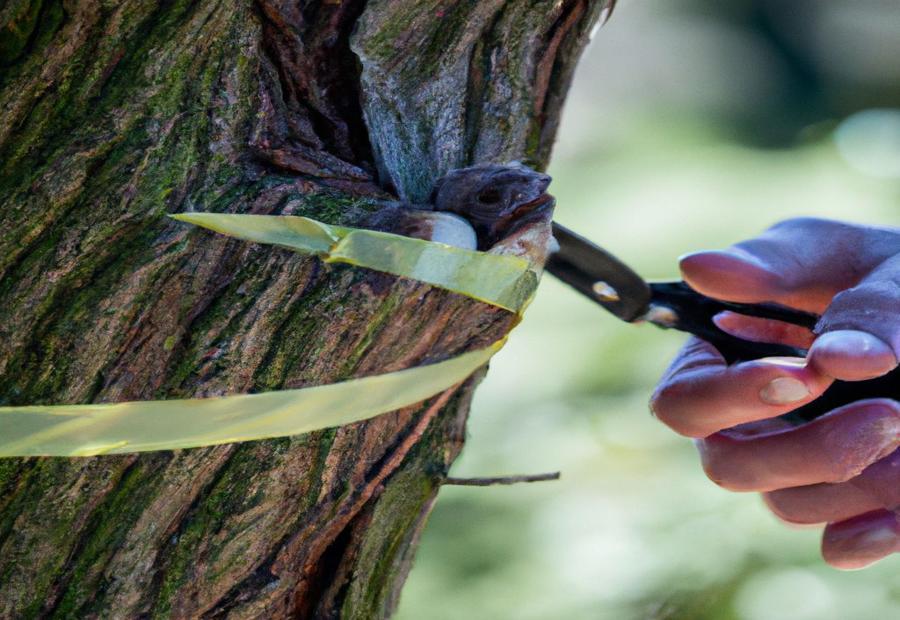
Photo Credits: Gardeninggurus.Org by Albert Lewis
Grafting steps and considerations play a crucial role in successful bonsai propagation. From thorough preparation to precise execution, each sub-section will guide you through the process of grafting. Discover the essential steps, considerations, and post-grafting care required to cultivate healthy and thriving bonsai trees.
Preparation before Grafting
Pre-grafting preparation is key for successful bonsai cultivation. Firstly, scions and rootstocks should be chosen with desired characteristics. Tools like sharp cutting implements, grafting tape, and disinfectant solutions should be ready. Sterilize tools to reduce the risk of infection. Timing should also be taken into consideration. Research climate and tree species requirements.
To boost success rates, keep equipment clean and sterilized. Choose scions and rootstocks of similar size. Make precise and clean cuts with sharp tools. Put pressure on the graft when securing it with tape or elastic bands. Provide the right environment and care post-grafting, such as maintaining moisture levels.
Following these steps and adequate preparation will increase chances of a successful graft. Preparation is essential for a healthy bonsai tree.
Executing the Grafting Process
Grafting bonsai requires several steps and considerations. To succeed, one must prepare before, execute the technique carefully, and protect the graft afterward. The following is a 4-step guide:
- Pick the right scion and rootstock: Choose a compatible scion (plant material) and rootstock (base). The fit between them is significant.
- Ready the tools and make clean cuts: Clean and sterilize tools like scissors and knives. Cut the scion and rootstock for better contact.
- Align and attach the graft: Place scion and rootstock together firmly. Use techniques such as whip-and-tongue, side-veneer, or cleft grafting. Secure with tape or ties, allowing airflow.
- Post-graft care: Monitor and provide conditions to heal and grow. Protect from harsh conditions. Check for infection or pests.
Other details for successful grafting include trimming excess foliage and controlling moisture. Following these guidelines can help create a strong and aesthetic bonsai. Each step is important for achieving success. Cleanliness, alignment, securing, post-graft care, as well as additional details, are essential.
Care and Protection after Grafting
After grafting, proper care and protection are essential for success. Here’s a 4-step guide:
- Provide Appropriate Environmental Conditions: Place the bonsai tree in a sunny spot with temperature control. Avoid extreme weather conditions like frost or heat.
- Watering: Keep the soil moist, not saturated. Check regularly and adjust accordingly.
- Protection from Pests: Inspect for signs of pests or diseases. Take measures to prevent infestations.
- Pruning and Wiring: Prune and wire branches to shape and direct growth. Avoid disturbing or damaging the grafted area.
Monitor health and inspect regularly. Species-specific references or experienced practitioners can help with optimum care practices.
Grafting Japanese Maple Bonsai Trees
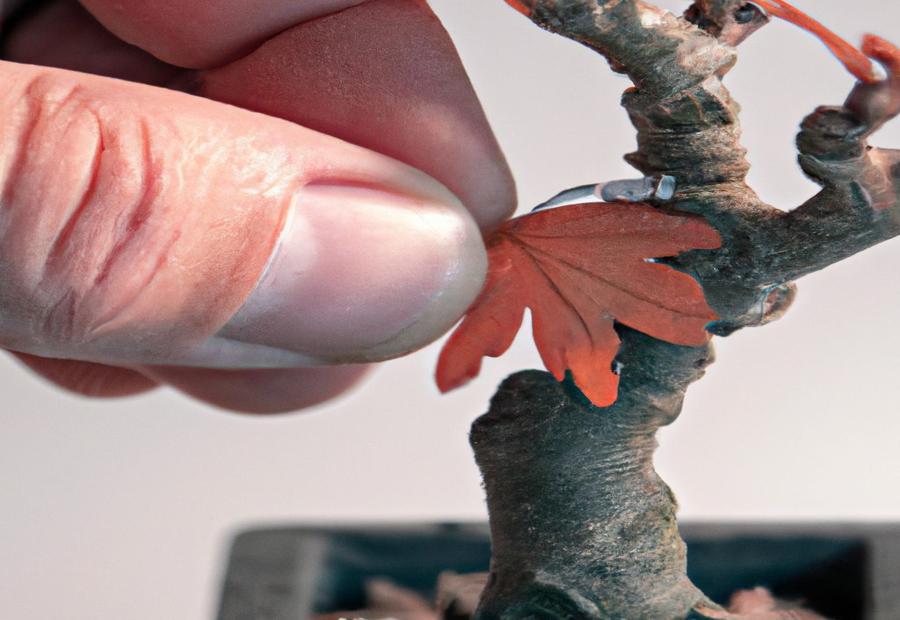
Photo Credits: Gardeninggurus.Org by Jacob Adams
Grafting Japanese Maple Bonsai Trees allows for the fusion of different plant tissues, creating unique and magnificent bonsai specimens. Discover the essential steps and tools required for this technique, explore the benefits it brings to the development of these miniature masterpieces, and learn about the care and maintenance necessary post-grafting. Harness the power of grafting to enhance the beauty and character of your Japanese Maple Bonsai.
Steps and Tools Required for Grafting
Grafting is a technique used in bonsai propagation to join cuttings to rootstocks for desired characteristics. It requires specific steps and tools. Here’s a 5-step guide to understand the steps and tools:
- Select a scion and rootstock. Choose healthy, compatible ones with a similar diameter.
- Prepare materials. Get sharp pruning shears or a grafting knife, grafting tape or nursery film, disinfectant solution, and rooting hormone (optional). Clean and maintain the tools.
- Make proper cuts. Create matching contact surfaces with clean, smooth cuts.
- Join the scion and rootstock. Fit them together, aligning their cambium layers. Secure them with tape or film, avoiding excess pressure.
- Provide care and protection. Shield the grafted area from weather, insects, or diseases. Monitor moisture levels and provide care.
Remember that each step is essential for successful grafting. By following the steps and using the right tools, you can get desirable results. Research specific techniques for different tree species before grafting, as they may have unique requirements.
Benefits of Grafting Japanese Maple Bonsai Trees
Grafting Japanese Maple bonsai trees offers a range of benefits. Combining different varieties allows for the selection of specific traits like vibrant colors and intricate leaf shapes. Grafting stimulates new growth, strengthens root systems, and provides a platform for creative expression. Plus, it can enhance the nebari and create multi-trunk styles.
But remember, grafting demands careful consideration. Make sure you have adequate knowledge of grafting techniques and maintenance practices to achieve success. Also, post-grafting care is essential. Bonsai trees require more attention than your regular house plants – so don’t forget to water them!
Explore the possibilities of grafting and witness the incredible results. Elevate your bonsai creations with grafting techniques and create unique Japanese Maple bonsai trees.
Care and Maintenance Post-Grafting
Grafting a bonsai tree requires more than just skill – proper care and maintenance post-grafting is crucial for successful growth and development. To ensure this, provide the necessary conditions for grafted branches or rootstocks to heal. Protect the graft site and watch out for signs of healing or rejection.
Plus, create a suitable environment for the bonsai tree. Shade newly grafted branches from heat and direct sunlight. Keep temperature steady. And, don’t over-fertilize – it may stress the tree. These steps will help the tree focus on healing and integrating!
Other Methods of Bonsai Propagation
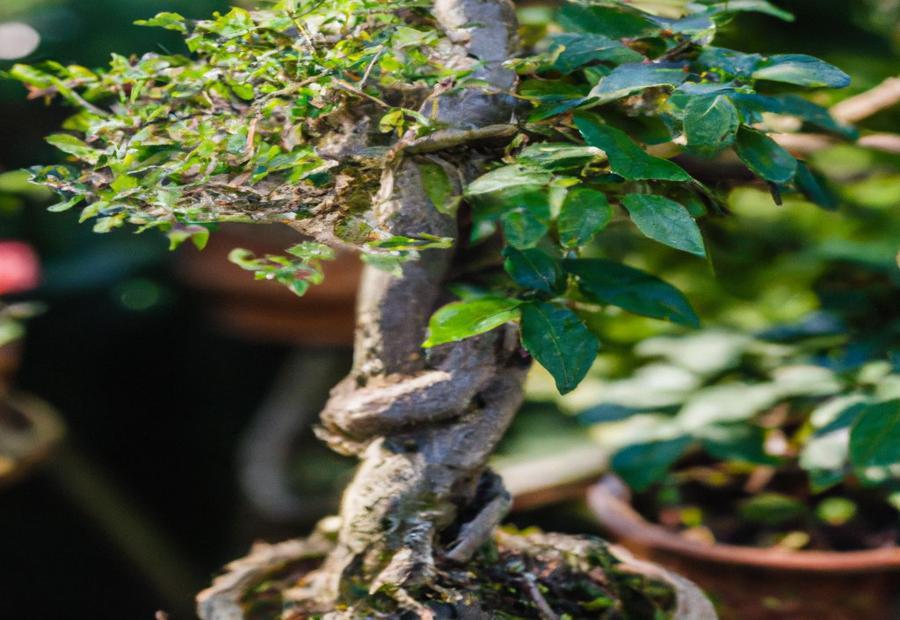
Photo Credits: Gardeninggurus.Org by Brandon Williams
Other Methods of Bonsai Propagation offers a range of techniques to expand your bonsai collection. From seed propagation, with its pros and cons, to the simple yet cost-effective cutting propagation method. Discover how air layering propagation creates wounds to stimulate root growth. Lastly, explore the art of grafting propagation, where cuttings are joined onto rootstocks to incorporate desired characteristics. Expand your bonsai horizons with these unique propagation methods.
Seed Propagation: Pros and Cons
Text:
Seed propagation for bonsai has its own perks and drawbacks. Pros? It’s a great way to get diverse tree types, costs little, and produces strong roots. Cons? Takes years to reach maturity, and limited control over characteristics. Weigh pros and cons and decide! Also, cutting propagation: scissors meet savings in the bonsai world.
Cutting Propagation: Simple and Cost-Effective Method
Cutting propagation is a simple and cost-effective method used in bonsai. It involves cutting a stem or branch from a parent tree and encouraging it to create roots and grow into a new plant. This technique is popular because it allows for the reproduction of desirable characteristics from existing trees in an easy and inexpensive way.
Follow this 5-step guide:
- Select the Cutting: Choose a healthy branch or stem with desirable characteristics like good trunk taper, interesting bark, or unique leaf shape. Make sure it’s 6-8″ long and has at least one or two nodes.
- Prepare the Cutting: Remove lower leaves or side branches, leaving a few at the top. Dip the cut end into rooting hormone powder.
- Plant the Cutting: Put it in a small pot with well-draining soil, like akadama and pumice. Make a hole and insert the cutting, burying at least one node beneath the soil.
- Provide Optimal Conditions: Keep the cutting warm and humid, like inside a propagator or covered with plastic wrap. Keep the soil moist but not waterlogged, with good airflow to prevent diseases.
- Nurture Growth: Check regularly for signs of growth. After several weeks, you may see roots. Expose the plant to more light and reduce humidity gradually.
Cutting propagation is easy and inexpensive. Select the right cuttings, provide proper care and you can effectively propagate and grow tree species in your bonsai collection. Bonsai cutting propagation has been practiced for centuries in Japan – where it originated. Creating wounds to stimulate root growth? Just another day at the bonsai office!
Air Layering Propagation: Creating Wounds to Stimulate Root Growth
Air layering propagation is a bonsai technique that encourages root growth. To do this, create wounds on a tree’s stem or branch by removing a ring of bark and cambium layer. This interrupts the flow of nutrients and water, prompting the tree to produce new roots.
- Step 1: Find a branch or stem with good growth potential.
- Step 2: Make an incision with a sharp knife or pruning shears. Remove a 1-inch wide ring of bark.
- Step 3: Coat the wound with rooting hormone. Wrap moist sphagnum moss or another rooting medium around the wound. Cover it with plastic wrap for a humid environment.
New roots will appear. Once there are enough, the air-layered section can be cut off and potted up as an independent bonsai tree.
Air layering propagation has many advantages. You can create new trees without disrupting the original design. It also often leads to quicker root development than other methods, meaning healthier plants.
Suggestions for successful air layering:
- 1. Pick a branch or stem thick enough to support roots.
- 2. Time air layering during active growing seasons.
- 3. Keep the rooting medium moist by misting or watering.
- 4. Protect new roots from sunlight or heat.
- 5. Monitor progress and remove dead or rotting material.
Follow these pointers and you’ll be harvesting healthy, well-established bonsai trees in no time!
Grafting Propagation: Joining Cuttings onto Rootstocks for Desired Characteristics
Grafting propagation is a technique used in bonsai cultivation. It involves attaching cuttings onto rootstocks for desired characteristics. This gives bonsai lovers control over the growth of their trees, and results in unique and beautiful specimens.
To do this, 5 steps are necessary:
- Select a healthy, compatible rootstock.
- Get a cutting, or scion, with the desired characteristics. Trim it to fit the rootstock.
- Make matching cuts on both the rootstock and scion.
- Place the scion onto the rootstock and secure with tape.
- Provide proper care and monitor for successful union.
Grafting has several advantages. It allows folks to create trees with unique foliage and improved branch structure. Plus, it produces faster growth than seed or cutting propagation.
Other bonsai propagation methods include seed, cutting, and air layering. Each has its own benefits and considerations.
Grafting is a great technique for bonsai cultivation. It gives people the ability to enhance their trees and shape them as desired. Understanding the steps and the specific characteristics of different species will help you successfully use grafting in your bonsai practice.
Suitable Tree Species for Bonsai Propagation

Photo Credits: Gardeninggurus.Org by Matthew Brown
When it comes to propagating bonsai trees, the choice of tree species is paramount. In this section, we will explore the tree species suitable for various propagation methods. From seed propagation to cutting propagation, air layering propagation, and grafting propagation, each sub-section will reveal the ideal species for these techniques. So, whether you’re a bonsai enthusiast or simply curious about the art of propagation, this section will provide valuable insights into the suitable tree species for successful bonsai cultivation.
Tree Species Suitable for Seed Propagation
Seed propagation is a common technique used in bonsai cultivation. It involves taking seeds and allowing them to grow into young plants, which can then be trained and shaped into bonsai trees. This process offers many advantages. For example, a wide variety of tree species can be grown and unique characteristics can develop in the trees. It is an important part of bonsai gardening, as it permits enthusiasts to cultivate trees from scratch and have control over their growth and development.
Popular tree species suitable for seed propagation in bonsai cultivation include Japanese Maple, Pine Trees, Juniper, and Chinese Elm. However, there are also other types of trees suitable for such propagation, such as oak, birch, maple, beech, and cedar. For more specialized tree species, research or advice from experienced growers can be obtained.
An inspiring story is told of a passionate bonsai enthusiast who experimented with seed propagation. He collected seeds from different tree species and nurtured them into young bonsai trees. Eventually, he created extraordinary and personalized bonsai specimens. This story demonstrates how seed propagation in bonsai cultivation can lead to unique and beautiful trees.
Alternatively, cutting propagation can be used as a simple and cost-effective way to let your bonsai grow.
Tree Species Suitable for Cutting Propagation
When propagating bonsai, certain tree species are chosen for their characteristics and ability to root from cuttings. These include: Trident Maple (Acer buergerianum), Chinese Elm (Ulmus parvifolia), and Japanese Black Pine (Pinus thunbergii).
These trees offer the advantage of creating new bonsai trees through cuttings, allowing for consistency. It is possible that other tree species can be suitable for cutting propagation too, but require different techniques or considerations.
Japanese Black Pine is especially popular for its adaptability to pruning and wiring. And to stimulate root growth, wounds are created – like a bonsai tree going through therapy, but with a sharper twist!
Tree Species Suitable for Air Layering Propagation
For air layering propagation, certain tree species have special traits that make them suitable. This process lets you make new trees by encouraging roots to grow on a branch that’s still connected to the parent tree. Pick the right tree species and you’ll have successful air layering propagation.
Grafting is the perfect DIY project for bonsai trees. Bonsai fans use grafting to craft unique, pleasing trees. It involves joining together plant parts, so they can combine and develop as one. People often use grafting to change the size, shape, or look of their bonsai tree.
Tree Species Suitable for Grafting Propagation
Tree species suitable for grafting propagation are essential for bonsai trees. Bonsai enthusiasts use various tree species, joining rootstocks with cuttings to make unique and pleasing bonsai trees. Grafting propagation lets them experiment to find specific traits like branch structure or leaf size. Through this technique, bonsai artists create stunning variations and combinations.
Japanese Maple is popular for bonsai cultivation and grafting. It offers many variations in leaf shape, color, and texture. Pines are also chosen for grafting. Their distinctive needle-like leaves and bark patterns make them visually appealing. Ficus tree species, like Ficus benjamina and Ficus microcarpa, work well for grafting. They have small oval or elliptical leaves and respond well to grafting. Junipers are ideal for grafting due to their ability to withstand various climates and malleable branches.
When selecting tree species for grafting propagation, it’s important to consider compatibility, plant health, and the bonsai artist’s goals. Each tree has different growth patterns and requirements.
Grafting propagation for bonsai has an ancient history, dating back centuries. Ancient Chinese horticulturists discovered and developed this technique. Over time, bonsai practitioners from different cultures have refined and adapted it, creating a wide variety of beautiful and unique bonsai specimens.
The art of grafting propagation pushes the boundaries of traditional tree cultivation. It allows for combining different tree species, creating bonsai trees with distinct features, shapes, and styles. Grafting is an essential tool for bonsai enthusiasts worldwide, helping them create their artistic visions. Adding branches and improving tree shape through grafting gives bonsai trees the makeover they deserve.
Applications of Grafting in Bonsai
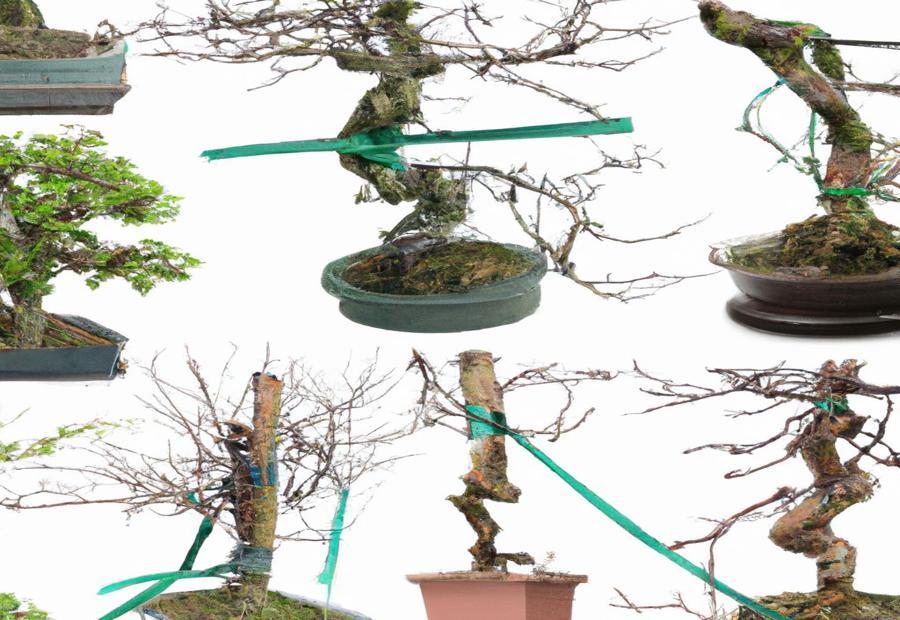
Photo Credits: Gardeninggurus.Org by Tyler Baker
Applications of grafting in bonsai are diverse and can greatly enhance the aesthetic appeal and overall health of the trees. By adding branches and improving tree shape, enhancing nebari with added roots, and creating multi-trunk style bonsai, bonsai enthusiasts can achieve stunning results. These techniques, supported by extensive research and practice, allow for the transformation and refinement of bonsai trees, ensuring their longevity and beauty.
Adding Branches and Improving Tree Shape
Bonsai cultivation demands strategic branch addition to create a balanced and harmonious tree form. To achieve this, one must use careful grafting techniques. Here’s a step-by-step guide to add branches and improve tree shape:
- Step 1: Choose scion branches with desirable characteristics like shape, size, and foliage color.
- Step 2: Prepare sharp, sterilized grafting tools – grafting knife, rubber bands, sealing compounds or wax.
- Step 3: Make precise cuts on both the scion and stock.
- Step 4: Fit the scion onto the stock and secure it in place.
- Step 5: Provide proper care and protect from extreme weather.
By following these steps, you can create a unique bonsai. Besides adding branches, grafting can also be used to add roots to enhance nebari and create multi-trunk style. The possibilities for creative expression are endless!
Adding Roots to Enhance Nebari
Adding roots is an important part of bonsai cultivation. It helps to improve the look of the tree by giving it stability and balance. There are two techniques for doing this: air layering propagation and approach grafting.
Step-by-Step Guide:
- Choose the area of the tree where you want the roots.
- Use air layering to stimulate root growth. This requires removing bark from the selected area, adding rooting hormone, and wrapping it in moist sphagnum moss or plastic wrap.
- Wait a few months until the new roots have grown.
- Take the air layering device off and remove the new roots from the parent tree.
- Plant the rooted section into a container or pot with the right substrate.
By doing this, you can make your bonsai look better and more balanced. Note that each species of tree may respond differently to these techniques.
Fun Fact:
Japanese Maple trees (Acer palmatum) are popular for bonsai projects. They have stunning foliage colors and branching patterns, making them great for enhancing nebari.
Want More?
Create a multi-trunk bonsai tree! It’s the perfect way to show off your style.
Creating Multi-Trunk Style Bonsai
Creating a multi-trunk style bonsai is an art! It requires skillful arrangement and cultivation of multiple trunks in one tree. This adds depth and complexity, resulting in a captivating display. Selecting and shaping each trunk to resemble a mature tree found in nature is key.
To craft multi-trunk bonsai, three steps are essential:
- Firstly, choose tree species with multiple trunks or flexible branches. Examples include Japanese maples, junipers and elms.
- Secondly, shape and wire the trunks for desired shapes and positions. Techniques such as bending and adding twists are important.
- Lastly, pay attention to proportions like height, width, and thickness.
Other factors to consider include branch placement, foliage density, and pot selection. Plus, proper care and maintenance are key for long-term success.
This type of bonsai is highly sought-after and brings out an age and wisdom. It’s an opportunity to unlock endless possibilities and showcase skillful craftsmanship. Don’t miss out on this amazing art form!
Important Terms and Concepts in Bonsai Grafting
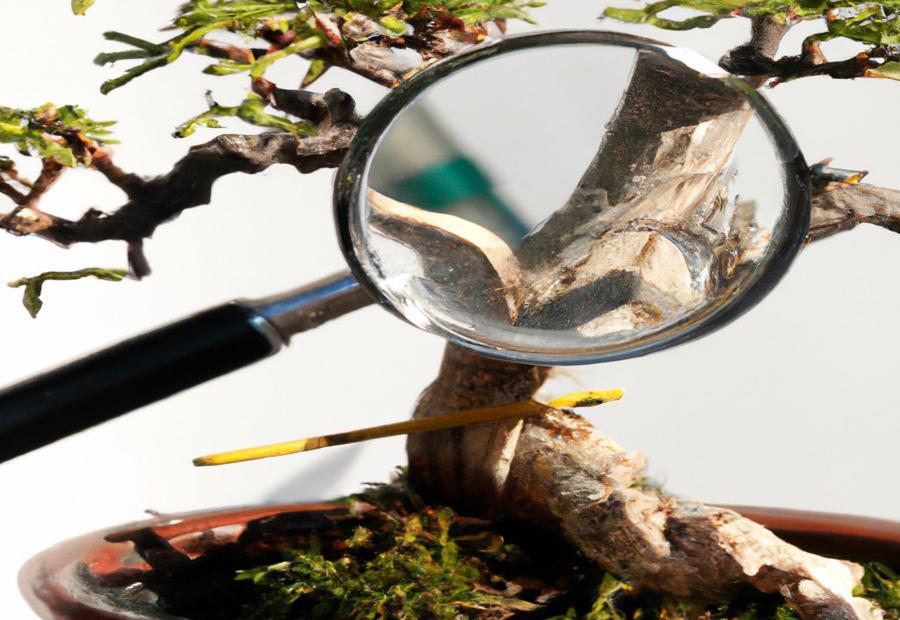
Photo Credits: Gardeninggurus.Org by Jesse Davis
Bonsai grafting is a propagation technique for bonsai trees. It joins two plants – the scion and rootstock – to make a new tree with desired characteristics. The scion has special foliage or flowers while the rootstock provides the roots and trunk. This way, bonsai fanatics can design unique and beautiful specimens.
To comprehend the terms and concepts in bonsai grafting, here are some key aspects:
- Scion: A chosen part of a tree to be grafted onto the rootstock. It is selected for its leaves, flowers, or bark shape and color. It is very important for the bonsai tree’s aesthetic qualities.
- Rootstock: The base for the scion. It offers the root system and trunk. It is normally picked for its vigorous growth and capability to support the scion.
- Graft union: Where the scion and rootstock meet. It is essential to join them tightly and sturdily for transferring water and nutrients between them. Proper care must be taken during the grafting process for a healthy union.
- Compatibility: The compatibility between scion and rootstock must be considered. Certain tree species or cultivars may not be compatible, resulting in a failed graft. Comprehending the compatibility between different plant varieties is vital for successful bonsai grafting.
By understanding these terms and concepts, enthusiasts can use the technique to make beautiful bonsai trees. Other factors like timing, grafting techniques, and aftercare are also essential. Timing is very important to coordinate the growth cycles of the scion and rootstock. Different grafting techniques like whip-and-tongue, approach, or thread grafting should be employed depending on what is needed. Aftercare like protection from extreme temperatures and regular maintenance is essential for the graft and bonsai tree’s health.
Conclusion

Photo Credits: Gardeninggurus.Org by Logan Thomas
To wrap it up, bonsai grafting and propagation are essential for bonsai lovers. They let you copy specific features, renew aged trees, and make fresh, special bonsai trees. Through grafting and propagation, bonsai fanatics can continually perfect their collection and brag about their craft and artistry. By comprehending and exercising these techniques, bonsai enthusiasts can discover a world of possibilities in the world of bonsai cultivation.
Some Facts About Bonsai Grafting And Propagation:
- ✅ Grafting is a method used by bonsai growers for tree propagation when other methods like cuttings or seeds are not feasible. (Source: Team Research)
- ✅ Popular tree species used for grafting include the five-needle pine and the Japanese black pine. (Source: Team Research)
- ✅ Nursery growers spend years to develop the skill of grafting and only 10 to 80 percent of grafts are successful, depending on the species. (Source: Team Research)
- ✅ There are three common techniques for Bonsai grafting: scion grafting, approach grafting, and thread grafting. (Source: Team Research)
- ✅ Grafting can be used to add branches, replace foliage, enhance root flare, combine desired characteristics, or create multi-trunk trees in bonsai. (Source: Team Research)
FAQs about Bonsai Grafting And Propagation
What is bonsai grafting and propagation?
Bonsai grafting and propagation are techniques used by bonsai growers to create new bonsai trees or enhance existing ones. Grafting involves joining a scion (shoot) onto a rootstock (root) to create a new, united tree, while propagation refers to the methods used to increase the number of bonsai trees, such as seed propagation, cutting propagation, air layering propagation, and grafting propagation.
What are the different methods of propagating bonsai trees?
There are four main methods of propagating bonsai trees: seed propagation, cutting propagation, air layering propagation, and grafting propagation. Seed propagation involves germinating seeds and caring for the seedlings. Cutting propagation involves taking a piece of leaf, stem, or roots from a healthy tree and encouraging it to develop roots. Air layering propagation involves creating a wound on a branch or trunk and promoting root growth. Grafting propagation involves joining a scion onto a rootstock to create a new tree.
When is the best time to perform bonsai grafting?
The timing of bonsai grafting depends on the tree species. For most tree species, grafting should be done in late winter, just before the buds start to swell. However, approach grafting should be done during the growing season when the growth of both plants is vigorous. Thread grafting, on the other hand, should be done when the tree is completely dormant.
What are the common techniques used in bonsai grafting?
The three common techniques used in bonsai grafting are scion grafting, approach grafting, and thread grafting. Scion grafting involves removing a small shoot or branch from a donor plant and inserting it into the receiving plant. Approach grafting involves attaching a donor plant with roots intact to the receiving plant. Thread grafting involves inserting a lower branch through a hole in the trunk.
What are the necessary tools for bonsai grafting?
Some important tools for bonsai grafting include trimming scissors, a fine saw, a grafting knife, a marker pen, nails or pins, a panel hammer, wound sealant, aluminum bonsai wire, and a plastic pot. These tools are used for making cuts, shaping branches, securing grafts, and protecting the tree during the grafting process.
What are the challenges faced in bonsai grafting?
Bonsai grafting can be challenging due to the complexities of the grafting process and the low success rate. Nursery growers spend years developing the skill of grafting, and only 10 to 80 percent of grafts are successful, depending on the species. Unbalanced trunk growth and scarring are common challenges faced by bonsai grafters. However, with extensive tree knowledge, different techniques, and artistic talent, bonsai grafters can overcome these challenges and create unique and desirable trees.


